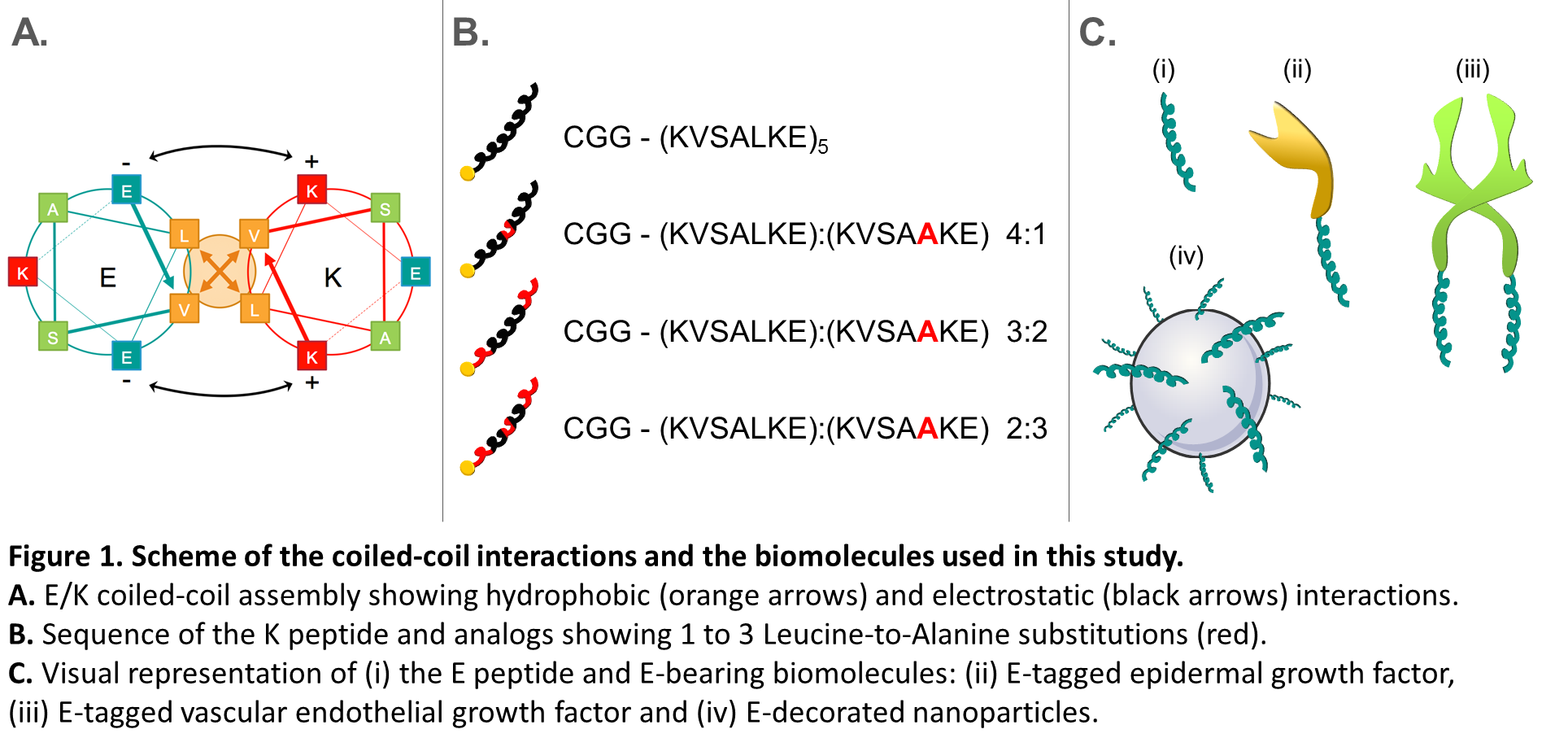Introduction: The coiled-coil assembly – a natural motif found ubiquitously in proteins – has recently (re)gained attention as a powerful tool for the development of biomaterials, in particular peptide-based and peptide-polymer hybrid nanomaterials[1],[2]. We have successfully used de novo designed complementary E and K peptides for the grafting of E-tagged growth factors on various K-decorated biomaterials (Fig. 1A). The specific attachment of the molecules mediated by the E/K coiled-coil interactions has notably demonstrated more potency when compared to non-site specific grafting methods[3]. This tool has been since refined, and we report here our work on the fine-tuning of the stability and affinity of the assembly by (a) precise residue substitutions in the K peptide and by (b) changes in the numbers of available E moieties on the grafted molecule.

Materials and Methods: Coil peptides and coil-tagged proteins were produced and purified as previously described[4]. Coil-decorated nanoparticles were produced by (i) auto-assembly of branched poly(ethylene imine) (PEI) and carboxymethylated dextran (CMD) bearing vinyl sulfone (VS) reactive groups then (ii) by reacting the cysteine-terminated E peptides with the VS groups. Surface plasmon resonance (SPR)-based assays were performed at 100 µL/min on a Biacore® T100 biosensor, using HBS-EP as running buffer.
Results and Discussion: Three K peptide analogs were designed with 1 to 3 Leucine-to-Alanine substitutions as a means to destabilize the hydrophobic core of the E/K assembly (Fig. 1A-B). SPR-based assays of the interaction of the E peptide with the K analogs were performed (Fig. 2A), and the kinetic analysis of the sensorgrams indicated that a wide range of affinities could be obtained, with apparent dissociation constants ranging from 137 pM to 14.8 nM.
Further SPR-based assays were performed with relevant biomolecules bearing a varying number of E moieties: E-tagged epidermal- and vascular endothelial growth factor, namely E-EGF and E-VEGF, as well as E-decorated PEI/CMD nanoparticles that could be used for nucleic acid encapsulation (Fig. 1C). The normalized responses obtained for a 50-nM injection of the tagged growth factors indicated that the number of E moieties affected both association and dissociation rates, as well as the amount that was recruited (data not shown). The enhancement of protein capture and stability was attributed to multivalent interactions occurring between the dimeric E-VEGF and the K-decorated surface, i.e., avidity causing an increase in the apparent affinity. Avidity was more plainly evidenced when nanoparticles bearing varying E densities were injected over the K peptide (Fig. 2B).

Conclusion: Two levers – the sequence of the K peptide and the number of E moieties – were here identified in the use of coiled-coil interactions for the controlled grafting and release of biomolecules, be it for the direct protein attachment onto tissue engineering scaffold or the transport of drugs or nucleic acids within nanoparticles.
This work was supported by the Canada Research Chair on Protein-Enhanced Biomaterials (G.D.C.), the Canada Research Chair in Applied Metabolic Engineering (M.J.), by the Natural Sciences and Engineering Research Council of Canada (G.D.C. and M.J.), by the Fonds de recherche du Québec - Nature et technologies (F.M. and C.F.) and by the MEDITIS training program (F.M. and C.F.).; We thank Josianne Lefebvre for technical support and fruitful discussion
References:
[1] Gerling-Driessen, U. I. M.; Mujkic-Ninnemann, N.; Ponader, D.; Schöne, D.; Hartmann, L., Exploiting Oligo(amido amine) Backbones for the Multivalent Presentation of Coiled-Coil Peptides. Biomacromolecules 2015, 16, (8), 2394-2402.
[2] Aronsson, C.; Dånmark, S.; Zhou, F.; Öberg, P.; Enander, K.; Su, H.; Aili, D., Self-sorting heterodimeric coiled coil peptides with defined and tuneable self-assembly properties. Scientific Reports 2015, 5, 14063.
[3] Lequoy, P.; Liberelle, B.; De Crescenzo, G.; Lerouge, S., Additive benefits of chondroitin sulfate and oriented tethered epidermal growth factor for vascular smooth muscle cell survival. Macromol. Biosci. 2014, 14, (5), 720-30.
[4] Murschel, F.; Liberelle, B.; St-Laurent, G.; Jolicoeur, M.; Durocher, Y.; De Crescenzo, G., Coiled-coil-mediated grafting of bioactive vascular endothelial growth factor. Acta Biomater. 2013, 9, (6), 6806-6813.